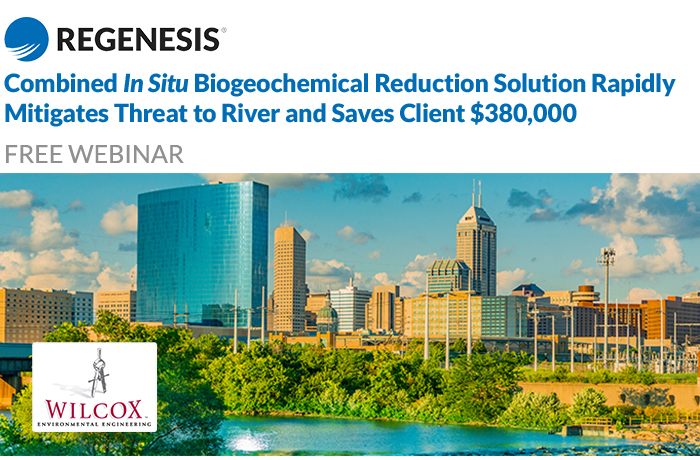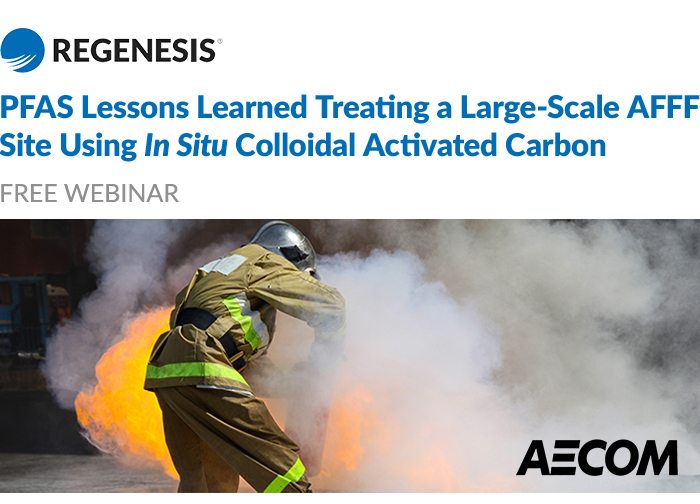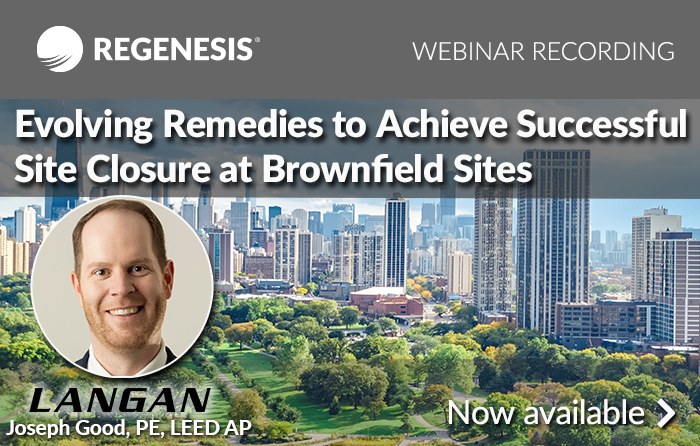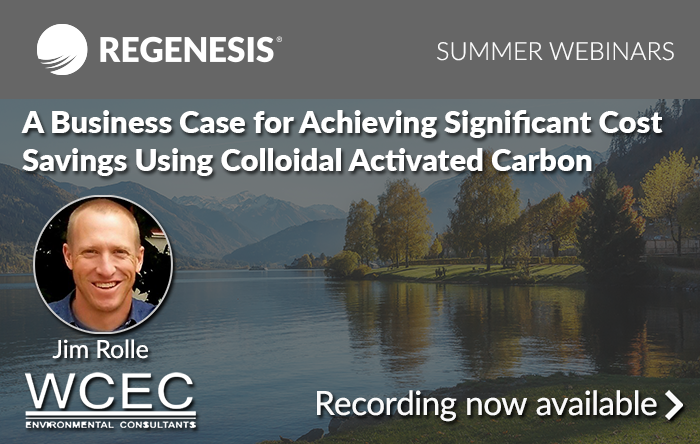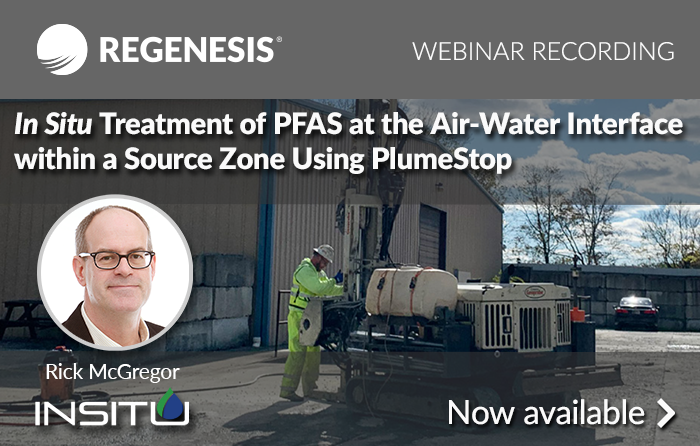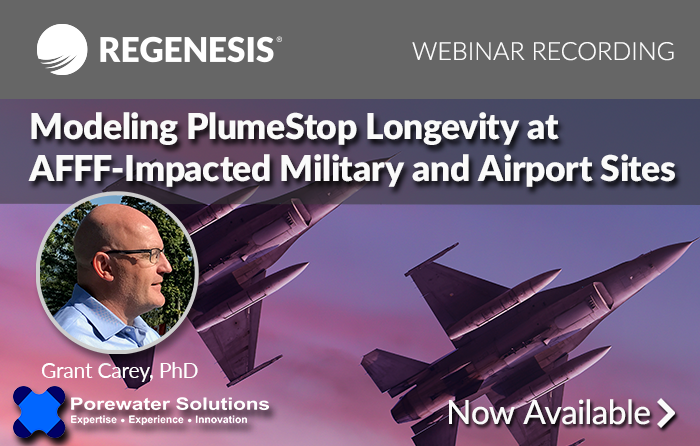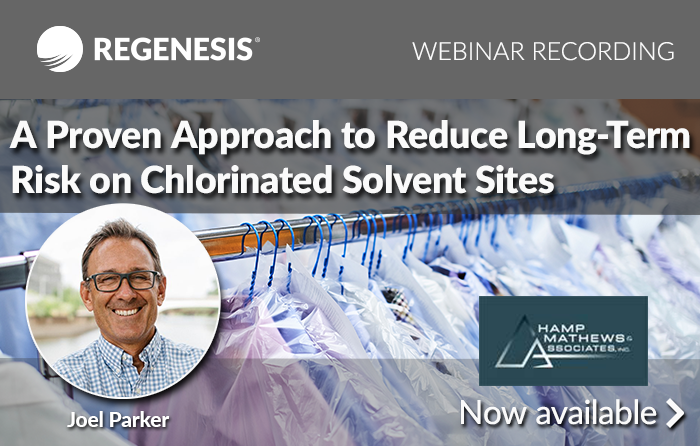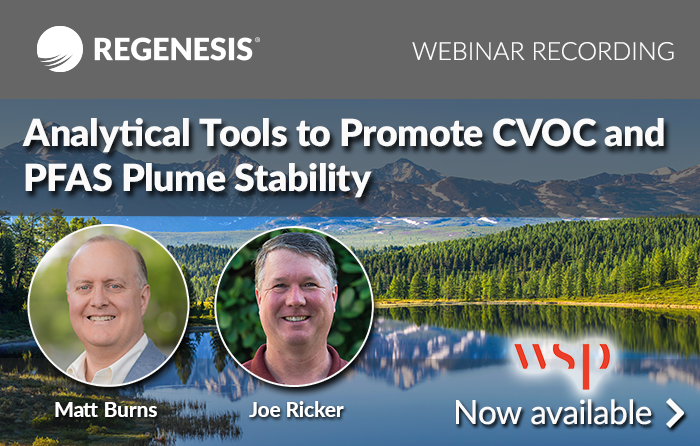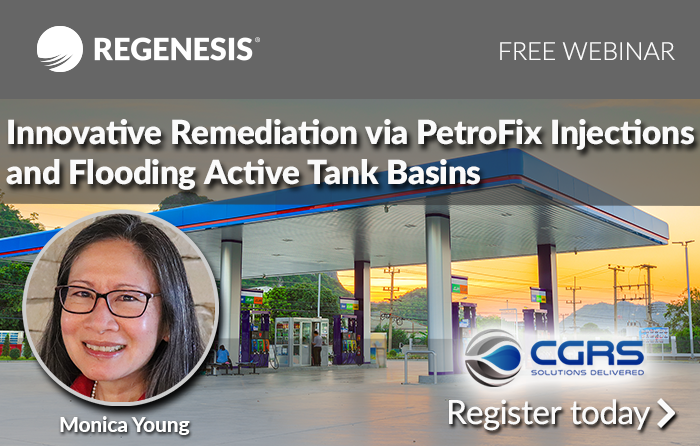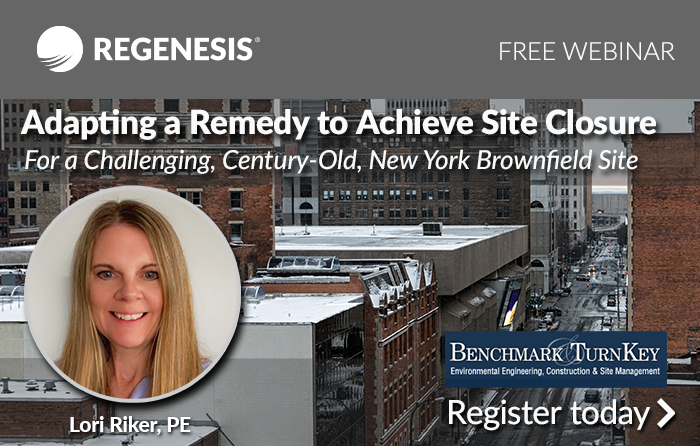Combined In-Situ Biogeochemical Reduction Solution Rapidly Mitigates Threat to River and Saves Client $380,000
Date: Thursday, July 25th, 2024
Time: 11am pacific / 2pm eastern
In this webinar we are pleased to have a remediation experts, Scott Connors, Senior Geologist at Wilcox Environmental Engineering, Brett Hicks, Central Region Manager at REGENESIS, and Todd Herrington, Director of Product Management at REGENESIS discuss a remediation project site where a combined in situ biogeochemical reduction solution rapidly mitigated a threat to a river and saved a client $380,000.
Webinar Highlights:
- Technology selection process leading to the application of PlumeStop and S-MicroZVI to rapidly achieve site goals
- Use of FluxTracers results in significant adjustments to horizontal and vertical treatment intervals, saving $380,000 in injectant material
- TCE effectively treated using advanced colloidal technologies to halt plume migration to a nearby river
Complete the form on this page to sign up for this free webinar.
Sign up today
PFAS Lessons Learned Treating a Large-Scale AFFF Site Using In-Situ Colloidal Activated Carbon
We were pleased to host Rebecca Mora, AECOM Associate Vice President and Senior Technical Leader who presented PFAS lessons learned while effectively treating a large-scale, AFFF release in situ using colloidal activated carbon (CAC). The complicated, high-concentration site represents one of the longest CAC permeable reactive barriers installed to address PFAS impacts, measuring over 1,600 feet long. She was joined by Ryan Moore, PFAS Remediation Program Director at REGENESIS.
Highlights of this free webinar:
- Approach, lessons learned, and performance results after 2 years of post-injection monitoring from an in situ application of a 1,635-foot-long colloidal activated carbon barrier to mitigate PFAS migration
- Rapid implementation of remedial solution due to perceived regulatory and public pressure
- Treatment addressing high concentrations of PFAS (up to 550 ppb)
- Remedial objective to reduce PFAS concentrations in groundwater migrating towards nearby off-site drainage ditches
Complete the form on this page to view this free webinar.
Recording now available
Evolving Remedies to Achieve Successful Site Closure at Brownfield Sites
In this webinar we were pleased to have special guest speaker Joseph Good, PE, LEED AP, Associate at Langan. His presentation discussed brownfield remediation projects that highlight the importance of evolving remedies for successful site closure. He was joined by Maureen Dooley, Vice President – Industrial Sector at REGENESIS.
Highlights of this webinar:
- Field case studies from urban brownfield remediation sites from investigation phase through treatability studies and field implementation
- Successful adjustments to initial remedial plans due to findings during the field implementation
- Responding effectively to evolving development schedules/plans to facilitate successful completion of the remedial program
Environmental remediations are carefully planned from the extensive field investigations that makeup the basis for design through the research and development of cutting-edge remedial products. Bench-scale studies are performed to confirm applicability and determine design parameters for the in-situ remedy implementation. While the latest scientific research combined with site-specific data may provide confidence in achieving remedial goals, there are often complications with execution of the remedy that require amendments and adjustments to reach the desired endpoint and final site closure. This presentation will include evaluation of multiple urban brownfield remediation sites from investigation phase through treatability studies and field implementation. This presentation will highlight adjustments to initial remedial plans due to findings during the field implementation, subsequent monitoring, and evolving development schedules/plans to facilitate successful completion of the remedial program. Key findings from each project will highlight the importance of evolving remedies to successful site closure.
Complete the form on this page to view this free webinar.
Recording now available
A Business Case for Achieving Significant Cost Savings Using Colloidal Activated Carbon
In this webinar we were pleased to have special guest speaker Jim Rolle, Director of Environmental Services at WCEC. His presentation discussed a business case for the use of colloidal activated carbon. He was joined by Todd Herrington, Global PetroFix Product Manager at REGENESIS.
Highlights of this webinar:
- Conceptual site model development for in situ remediation
- A business analysis of long-term monitoring versus in situ remediation at a Washington site
- A new strategy for using colloidal activated carbon for in situ remediation
Complete the form on this page to view this free webinar.
Recording Now Available
In-Situ Treatment of PFAS at the Air-Water Interface within a Source Zone Using PlumeStop
In this webinar we were pleased to have as a special guest speaker Rick McGregor, President of InSitu Remediation Services Ltd. His presentation discussed the in situ treatment of PFAS at the air-water interface within a source zone using PlumeStop.
Highlights of this free webinar:
- Case studies presented of field sites with six different PFAS contaminants where PlumeStop was injected at the interface between vadose and saturated zones
- 34 of 36 monitoring events show non-detect for all PFAS except PFPeA for 2 years and counting
- Distribution of PlumeStop confirmed with the target treatment areas for all sites
Complete the form on this page to view this free webinar.
Recording Now Available
Modeling PlumeStop Longevity at AFFF-Impacted Military and Airport Sites
In this webinar we were pleased to have as a special guest speaker, globally-recognized PFAS modeling expert and recent lead author of the REMEDIATION Journal article titled Longevity of colloidal activated carbon for in situ PFAS remediation at AFFF-contaminated airport sites, Grant Carey, PhD, President of Porewater Solutions. His presentation discussed modeling PlumeStop® longevity at AFFF-impacted military and airport sites. He was joined by Scott Wilson, President & CEO of REGENESIS, who provided an update on the use of colloidal activated carbon as a sustainable, low-cost method to eliminate PFAS risk and liability.
Highlights of this free webinar:
- Case studies of 17 PFAS field sites showing successful PlumeStop performance results for up to six years and counting
- In-Situ Remediation Model (ISR-MT3DMS) indicates PlumeStop longevity that may occur at a wide range of AFFF-impacted military and airport sites
- Remedial alternatives that may be used in combination with PlumeStop at AFFF-impacted sites will be discussed
There is growing interest in the use of PlumeStop to sequester PFAS in groundwater sorption zones. PlumeStop contains colloidal activated carbon (CAC) particles which are sufficiently small to allow for easy injection into porous media. The performance of PlumeStop at 17 PFAS field sites is summarized, including upgradient concentrations of PFAS, organic co-contaminants, and native organic matter; and the fraction of CAC in soil after injection. These case studies demonstrate that PlumeStop has been used successfully at PFAS field sites with total monitoring periods to-date ranging from 0.3 to six years.
A review of state and federal guidance indicates that the four most frequent PFAS of interest are PFOS, PFOA, PFHxS, and PFNA. A sensitivity analysis using the In-Situ Remediation Model (ISR-MT3DMS) illustrates the magnitude of PlumeStop longevity that may occur at a wide range of AFFF-impacted military and airport sites. A statistical analysis of PFAS concentrations at 96 AFFF-impacted sites and laboratory batch tests supported this modeling study. Various influencing factors were modeled, including plume concentrations, groundwater velocity, the engineered fraction of CAC in soil, and sorption isotherm properties. Remedial alternatives that may be used in combination with PlumeStop at AFFF-impacted sites are discussed.
Complete the form on this page to view this free webinar.
Webinar recording available
A Proven Approach to Reduce Long-Term Risk on PCE Sites
In this webinar we were pleased to have special guest speaker Joel Parker, Principal Engineer at Hamp Mathews & Associates. His presentation discussed reducing long-term risk for chlorinated solvent contaminated sites including dry cleaning and industrial manufacturing sites. He was joined by Ryan Moore, Senior Technical Manager at REGENESIS.
Highlights of this free webinar:
- A former dry cleaner site represented a vapor intrusion (VI) risk to nearby residents in Temperance, Michigan
- Sulfidated ZVI, electron donor and colloidal activated carbon were implemented in source areas and in barrier-type configurations at mid-plume and distal plume locations
- Groundwater monitoring at source and receptor flowpaths have demonstrated significant reduction in PCE, TCE, and cis-1,2-DCE without accumulation of vinyl chloride
- Results achieved and the field application/approaches will be presented, and remedial injectant and implementation logistics will be discussed
Complete the form on this page to view this free webinar.
Recording now available
Analytical Tools to Promote CVOC and PFAS Plume Stability
In this webinar we are pleased to have special guest speakers WSP’s Matt Burns, VP and Technical Director of the Earth and Environment Practice, and Joe Ricker, Senior Technical Principal. Their presentation will discuss the use of plume analytics, focusing on its potential applicability to MNA of PFAS, and its usefulness in assessing CVOC plume stability. They will be joined by Maureen Dooley, Vice President – Industrial Sector at REGENESIS.
Highlights of this free webinar:
- Potential applicability of plume analytics to MNA of PFAS
- Using analytics to assess plume stability and other plume attributes, with examples from remediation sites
- Use of colloidal activate carbon to eliminate risk of PFAS contamination in groundwater
Complete the form on this page to sign up for this free webinar.
Recording now available
Innovative Remediation via PetroFix Injections and Flooding Active Tank Basins
In this webinar we were pleased to have as a special guest speaker Monica Young, Senior Project Manager at CGRS, Inc. Her presentation discussed a wide range of sites where CGRS has successfully applied PetroFix liquid carbon amendment to address petroleum hydrocarbon impacts. Application methods and results using direct push injection among other application approaches to reach Tier IV risk-based closure was discussed. She was joined by Todd Herrington, Global PetroFix Product Manager at REGENESIS, who iscussed PetroFix and new in-situ approaches it is being utilized for.
Highlights of this free webinar:
- Petroleum hydrocarbon impacted sites achieving beneficial results using PetroFix via two different methods of application
- PetroFix injected via direct push into the subsurface to achieve Tier IV risk-based closure
- PetroFix injected into an active UST basin via shallow injection wells
Recording now available
A Remedy to Achieve Site Closure: Fast and Permanent Remedy Replaces Pump and Treat System
Date: Wednesday, March 30th, 2022
Time: 11am pacific / 2pm eastern
In this webinar we are pleased to have as a special guest speaker Lori E. Riker, P.E., Sr. Project Manager at Benchmark Civil/Environmental Engineering & Geology. Her presentation will discuss adapting a remedy to achieve site closure for a challenging, century-old, New York Brownfield site. She will be joined by Alana Miller, Northeast District Technical Manager at REGENESIS, who will share how in-situ technologies were adapted for a remedial solution at this site.
Highlights of this free webinar:
- CVOCs impacting groundwater at a former manufacturing site in New York formed a narrow plume migrating off-site
- PlumeStop colloidal activated carbon technology applied as a fast and permanent remedy to replace a pump-and-treat system that had operated from 2004-2018
- Successful site performance data for six sampling events resulted in decommissioning of pump-and-treat system and site regulatory closure from NYSDEC
At a former metals manufacturing facility in Western New York, a narrow CVOC plume was migrating off-site. Over 30 million gallons of CVOC-impacted groundwater were treated between 2004 and 2018 using a pump-and-treat system. Since the site owner was interested in implementing a fast and permanent remedy, an in situ application of PlumeStop colloidal activated carbon (with electron donor, and bioaugmentation substrates) was completed in 2017 by REGENESIS Remediation Services (RRS). Performance monitoring was conducted through June 2021. Following the application, CVOC concentrations were reduced from as high as 500 micrograms per liter (µg/L) at baseline to below one ug/L in the source area and downgradient performance monitoring wells for six consecutive sampling events. Based on these results, the pump-and-treat system was decommissioned, and the site was granted closure by the NYSDEC in August 2021, after nearly 20 years of investigation and remediation.

 Americas
Americas Europe
Europe Français
Français Deutsch
Deutsch Italiano
Italiano Español
Español